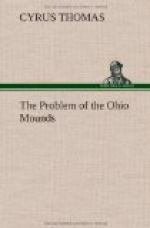In this region the modifications begin, as heretofore shown, and continue along the belt mentioned through West Virginia, culminating in the modern form in western North Carolina and East Tennessee.
As pipes of this form have never been found in connection with the stone graves, there are just grounds for eliminating the Shawnees from the supposed authors of the Ohio works. On the other hand, the engraved shells are limited almost exclusively to the works of the Shawnees and Cherokees (taking for granted that the former were the authors of the box-shaped stone graves south of the Ohio and the latter of the works in western North Carolina and East Tennessee), but are wanting in the Ohio mounds. It follows, therefore, if the theory here advanced (that the Cherokees constructed some of the typical works of Ohio) be sustained, that these specimens of art are of Southern origin, as the figures indicate, and that the Cherokees began using them only after they had reached their historical locality.
Other reasons for eliminating the Shawnees and other Southern tribes from the supposed authors of the typical Ohio works are furnished by the character, form, and ornamentation of the pottery of the two sections, which are readily distinguished from each other.
That the Cherokees and Shawnees were distinct tribes, and that the few similarities in customs and art between them were due to vicinage and intercourse are well-known historical facts. But there is nothing of this kind to forbid the supposition that the former were the authors of some of the Ohio works. Moreover, the evidence that they came from a more northern locality, added to that furnished by the pipes, seems to connect them with the Ohio mound-builders. In addition to this there is the tradition of the Delawares, given by Heckewelder, which appears to relate to no known tribe unless it be the Cherokees. Although this tradition has often been mentioned in works relating to Indians and kindred subjects, it is repeated here that the reader may judge for himself as to its bearing on the subject now under consideration:
The Lenni Lenape (according to the tradition handed down to them by their ancestors) resided many hundred years ago in a very distant country in the western part of the American continent. For some reason which I do not find accounted for, they determined on migrating to the eastward, and accordingly set out together in a body. After a very long journey and many nights’ encampments [Footnote: “Many Nights’ encampment” is a halt of one year at a place.] by the way, they at length arrived on the Namaesi-Sipu, [Footnote: The Mississippi or The River of Fish; Namaes, a fish, and Sipu a river.] where they fell in with the Mengwe, [Footnote: The Iroquois, or Five Nations.] who had likewise emigrated from a distant country, and had struck upon this river somewhat higher up. Their object was the same with that of the Delawares; they were proceeding on




